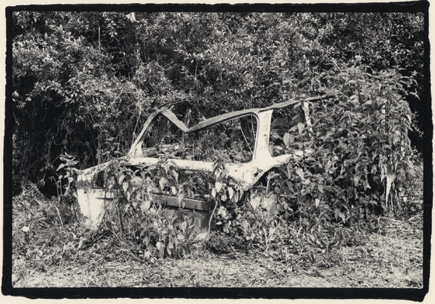The Darkroom
When Good Chemicals Go Bad; Tips For Maintaining Freshness And Best Image Quality Page 2
Change in alkalinity (pH) is a result of the formation of hydrobromic acid when the silver is developed. This is immediately neutralized by the excess alkali, thus resulting in a drop in pH. The less alkaline most developers are, the less active they are, so a reused developer may be significantly less active than a fresh one. A few developers, especially unbuffered Kodak D-76, cycle up and down in pH as they sit on the shelf. Their activity at the peak of their cycle is somewhat different from their activity at the trough.
Exhaustion of the developing agents, in the sense of their being used up, is actually quite rare. It normally happens only with very dilute developers containing relatively tiny amounts of developing agent--in which case oxidation may also be a major contributing factor. Many developers with two developing agents rely on the regeneration of one agent by the other, so one is used up while the other is regenerated.
The amount of developer needed for a given area of film is often greatly overestimated. Most of the developer is there in order to make sure that the film is wetted quickly and evenly. The amount that does the actual work is tiny.
To take an extreme example, imagine a two-bath developer in which all the developing agent is in the first bath: a typical formula uses 5 gm/liter of metol. Fill a 35mm single-reel stainless steel tank with 250ml of developer; let it soak for 5 minutes, with some agitation; pour it out. About 25ml at the outside will remain behind, and of this, a good proportion is simply wetting the tank. In that 25ml (0.025 liters) of developer, otherwise defined as 0.04 liters, there is 5x0.025 gm of metol: 1/8 of a gram. This is enough to develop the whole film.
Because of the dangers inherent in reusing developers, and the unpredictable activity of reused developers, it is a very good idea to develop films "one shot" whenever possible, using dilute developers and throwing them away after a single use.
 |
|
|
Short Stop
The vast majority of developers are alkaline: only a very few developing agents
will work quickly (if at all) in an acid environment. Short stop is a weak acid
which neutralizes the alkalinity of the developer.
The classic short stop is acetic acid. Citric acid does not have the same penetrating,
irritating smell, but neither does it have the capacity of acetic acid. Also,
citric acid can support algae or slime if it is left too long: acetic acid won't.
Stop baths can be reused repeatedly until they lose their acidity. Some incorporate
indicators that change color when this happens: typically, they go from yellow
to purple. Otherwise you can use litmus paper or simply replace the stop bath
frequently enough that it is unlikely to exhaust. Stop baths are cheap enough,
after all, especially if you make them up from dilute acetic acid as I do. A
typical stop bath is 2-4 percent acetic acid.
Fixer
As fixer is used, two things happen. First, its activity gradually slows down.
Second, more and more silver goes into solution as silver thiosulphates.
The first is the main consideration with film and there is an easy test. Take
a small piece of unexposed, undeveloped film and put a drop of fixer on it.
Leave it for about 20 seconds. Then throw the scrap of film into the fixer,
making sure it is covered. Time how long it takes for the clear spot (from the
drop of fixer) to disappear. This is the clearing time. Fix the film for at
least twice this time and at most three times. When the clearing time is twice
the clearing time for fresh fixer, throw out the fixer and start again. This
gives a good margin for error: you could actually wait until clearing time tripled,
and not have to worry, but fixing times become inconveniently long.
With paper, silver build-up is the main problem. The silver salts that result
from fixation are hard to wash out of the paper, and will stain if they are
not washed out, so it is important never to overwork paper fixer. This is why
the capacity of a paper fixer is almost independent of concentration. Film-strength
fixer (typically 1+3 or 1+4) will fix paper much faster than paper-strength
(anything up to 1+9) but its capacity is the same.
The only easy way to test silver build-up is with silver test papers but these
are fairly short lived, quite expensive, and normally available only in packets
of 10 booklets, so they are not very practical for the home darkroom. The easiest
approach is to follow the manufacturers' guidelines. These are slightly
wasteful, to allow a margin of safety, but they are better than losing your
prints. If you want to save money, work at the lowest recommended fixer concentration,
but be sure to fix for the fully recommended time.
Bleaches And Toners
Mostly these just get slower and slower, so it is a matter of deciding when
you can no longer stand the delay. A few may actually oxidize or hydrolyze,
but as this also results in their slowing down, this tends to be a distinction
without a difference. Few if any bleaches and toners will stain prints even
if they are hopelessly old, though I have had bad experiences with old, home-compounded
iron toners staining the paper green or yellow.
Time And Temperature Development
All conventional films and papers (other than lith papers) should be developed
by the time and temperature method. Films must be developed for the correct
time to give the degree of contrast you need (use the manufacturers' recommendations
or conduct your own tests) while papers should be developed to completion. A
paper that is not developed to completion will not give the maximum tonal range
of which it is capable. If it needs to be "snatched" from the developer
because it is darkening too fast you have overexposed the print. Throw it away
and make another. Many years ago, papers were not always designed to be developed
to completion, but today, the vast majority are.
- Log in or register to post comments

















































